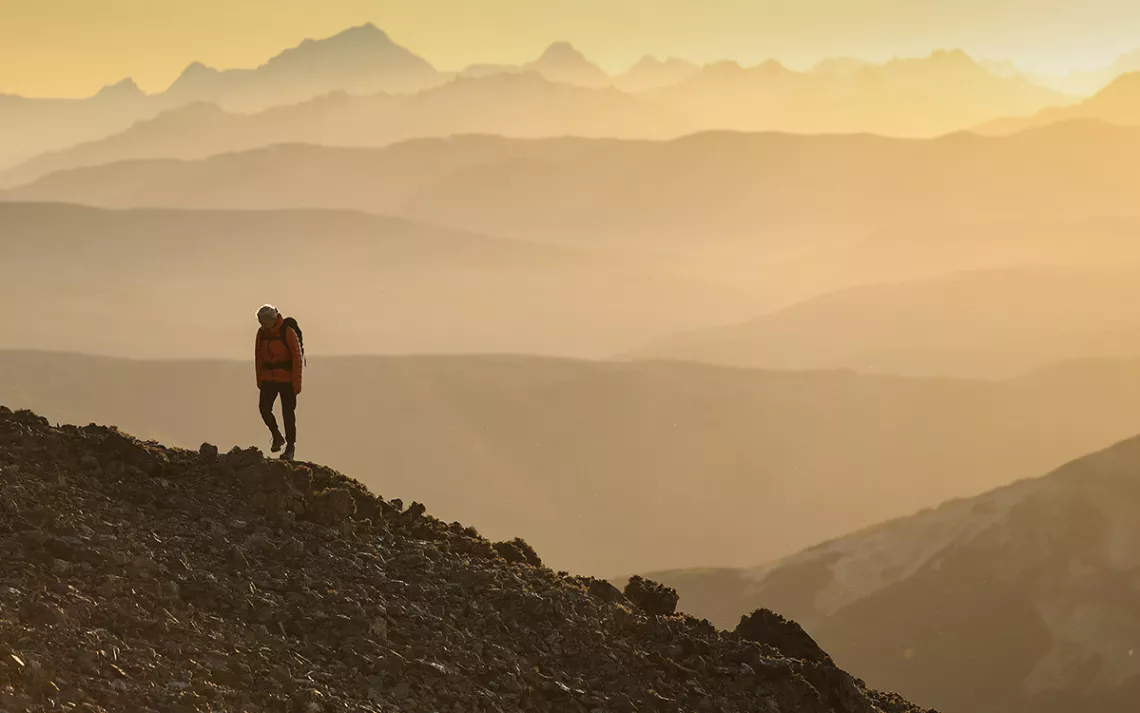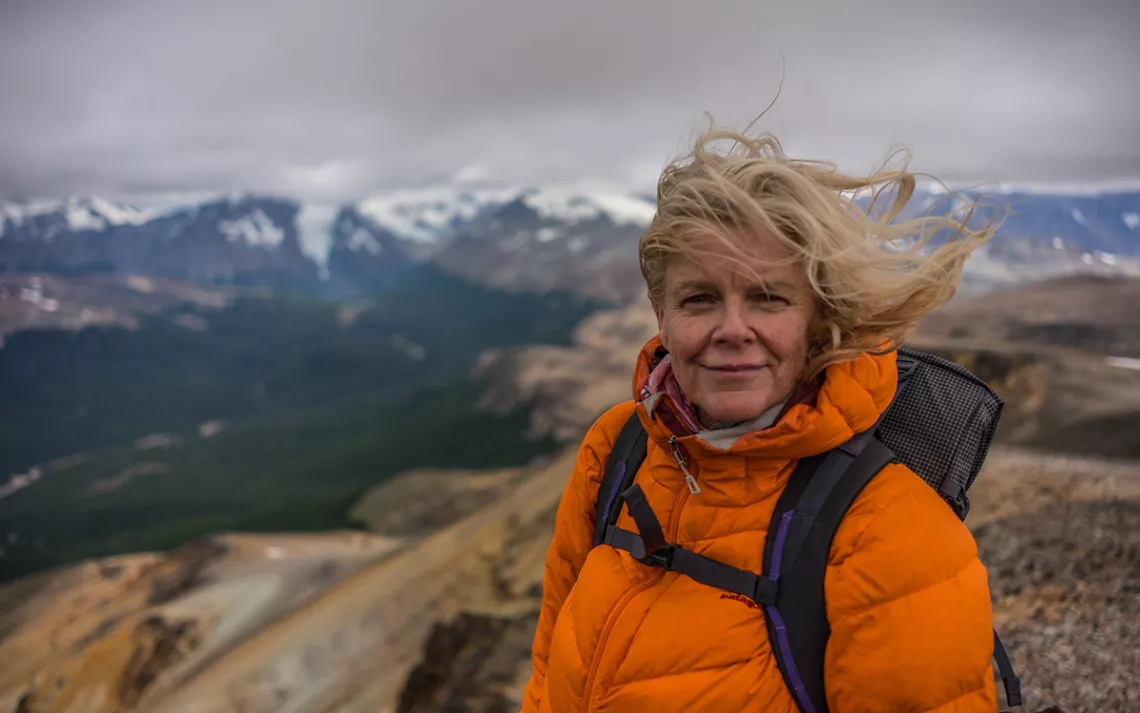From Catastrophe to Conservation Triumph
The new film “Wild Life” details the love story of Doug and Kris Tompkins and their historic vision for conservation

Kris Tompkins hikes with a Patagonian mountain range as her backdrop. | Photo by Jimmy Chin
Wild Life opens with a woman and a choice—give up or go to work.
“I’d lost the love of my life. I was seriously wounded, on my knees,” says conservationist Kris Tompkins in the film’s opening scenes as she describes the aftermath of her husband’s unexpected death. A friend presented to her two paths: “‘You can mourn Doug for the rest of your life, or you can go to work. What are you going to do?’” Kris recounts. “And that was a choice.”
Kris and her late husband, Douglas Tompkins—renowned conservationist, founder of the North Face and cofounder of Esprit—had worked tirelessly to advance an ambitious conservation vision in Latin America. Rather than succumb to the grief, she resolutely fixes her mind to finish the projects that they had started 25 years ago. Through beautiful cinematography, Wild Life tells the story of Doug and Kris’s romance; of their pivot away from profiting in the outdoor industry to protecting the natural world; and ultimately, how the Tompkinses accomplished the largest private land donation in history. It is a tribute to Doug’s visionary life and legacy.
At its heart, however, the film is about Kris. Amid flashbacks of the couple’s youth, their budding romance, and political battles to conserve Chilean and Argentinian wilderness, Wild Life’s throughline is Kris’s climb of Cerro Kristine—a mountain Doug first ascended in 2008 and named after her—in the heart of one of the parks that had once been their private, protected land. Along the trekking journey, we watch Kris take in the sweeping Patagonian landscape with its craggy peaks, snowy glaciers, and verdant valleys. You can almost feel her spiritual closeness to her late husband in these moments. “This is the farthest I’ve been inside this park.… We never got on the ground enough. We didn’t really explore. We just worked,” Kris narrates as she climbs a talus field. This, she says, is her way of saying goodbye to him.
After he was kicked out of high school his senior year, Doug moved to California to scale Yosemite’s granite walls. There he met Yvon Chounaird, who at the time was metalsmithing climbing equipment to sell out of his car, a bootstrap enterprise that would eventually become gear and apparel company Patagonia. This slice of the narrative is less novel if you’re familiar with US climbing history and have heard once (or twice or thrice) a retelling of the golden age of Yosemite climbing, when mostly young white men were pioneering the frontiers of rock climbing between the 1950s and 1970s. No doubt, much of their work was indeed legendary as characters like Chounaird, Royal Robbins, and Tom Frost moved the sport forward in monumental ways. After films like National Geographic’s Valley Uprising (2014), however, it isn’t a particularly new story.

Kris Tompkins on her hike up the mountain range in Patagonia, Chile. | Photo by Jimmy Chin
Doug and Chounaird traveled to Patagonia in 1968 with a group (self-dubbed the “Fun Hogs”) and ascended a route on the iconic Fitz Roy peak, which they named “the Californian Route.” It was on this trip that Doug fell in love with the Patagonian landscape and Chounaird decided to make clothing that could withstand the region’s famously heinous weather. An astute observer might notice that the Patagonia logo features Fitz Roy’s silhouette.
Kris and Doug met through Chounaird in the 1970s. For the next 20 years, they would take equally prodigious yet different paths in industry. Kris pushed Patagonia to become an outdoor apparel titan as the company’s first CEO while Doug—after founding the North Face and selling it two years later in 1968—went into business with his then-wife Susie Tompkins, cofounding the luxury clothing company Esprit.
Wild Life illuminates several epiphanous turning points in Doug and Kris’s lives. After nearly two decades at Esprit, Doug realized that peddling fashion at the expense of the environment was against his personal ethics. For Kris, there were a couple such watershed moments—the first, in 1993 when she left Patagonia (the company) and moved to Patagonia (the place) to marry and live a joint life with Doug, becoming his conservation co-conspirator. The second such moment is Doug’s death. The film does not share the details of Doug’s demise until 60 minutes into its 93-minute run time. It is a vivid and difficult retelling of the kayaking accident in 2015 that took his life. While kayaking a Patagonian lake, windy conditions built eight-foot swells that capsized Doug’s sea kayak into 40ºF water. He ultimately succumbed to hypothermia.
It’s hard to keep your eyes dry at this point in Wild Life. My fiancé is a paddler and has journeyed across expansive lakes in northeastern Quebec, where getting caught out in high wind can spell a similarly quick death. I myself experienced my first boat flip in whitewater on an evening last November, a frigid time in the Tetons, where we live. Once you’ve been in bone-chilling water with waves slamming against your face as you struggle for air, you understand how rapidly such conditions can steal a life.
“It was an amputation, not just a loss,” Kris says after Doug’s death. Yet, “This big audacious vision of Doug’s was the thing that kept me in one piece. That was a life raft for me.” She cuts agricultural projects that Doug was stringing along even though they weren’t financially tenable. She makes some compromises, but not on the big stuff. When one of the potential parks is threatened, Kris puts it all on the line: “It was all or nothing. We do them all, or we do nothing.” It worked.
Wild Life is produced and directed by another couple, Oscar-winning filmmakers Chai Vasarhelyi and Jimmy Chin (Chin is a close friend of the Tompkinses and climbed Cerro Kristine with Doug the first time in 2008, and with Kris again after Doug’s passing). The duo captured 400 hours of footage over six years. Vasarhelyi shared that she had wanted for years to make a film about a “strong woman.”
Toward the end of Wild Life, we watch Kris and the Chilean president at the time, Michelle Bachelet, at the signing of a deal in which Tompkins Conservation donated 1 million acres of private land in exchange for the Chilean government’s donation of 10 million. “It was the biggest land conservation donation in history, and it was two women doing this and making it happen,” Kris reflects.
When faced with criticism from Chilean and Argentinian citizens and governments about the size of the Tompkinses’ land purchases, Kris labeled it a “drop in the bucket” compared to how much wilderness is being destroyed daily worldwide. When you consider that Kris and Doug have protected 14.8 million acres of Chilean and Argentinian parklands through Tompkins Conservation and its partners—in addition to rewilding many of these conserved areas with jaguars, guanacos, and other critical species—it’s a pretty large drop.
 The Magazine of The Sierra Club
The Magazine of The Sierra Club







